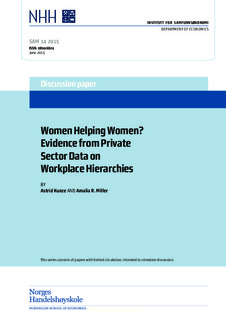| dc.description.abstract | This paper studies gender spillovers in career advancement using 11 years of
employer-employee matched data on the population of white-collar workers at over 4,000
private-sector establishments in Norway. Our data include unusually detailed job information for
each worker, which enables us to define seven hierarchical ranks that are consistent across
establishments and over time in order to measure promotions (defined as year-to-year rank
increases) even for individuals who change employers. We first find that women have
significantly lower promotion rates than men across all ranks of the corporate hierarchy, even
after controlling for a range of individual characteristics (age, education, tenure, experience) and
including fixed effects for current rank, year, industry, and even work establishment. In
measuring the effects of female coworkers, we find positive gender spillovers across ranks
(flowing from higher-ranking to lower-ranking women) but negative spillovers within ranks. The
finding that greater female representation at higher ranks narrows the gender gap in promotion
rates at lower ranks suggests that policies that increase female representation in corporate
leadership can have spillover benefits to women in lowers ranks. | nb_NO |
